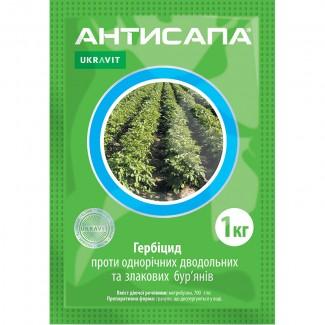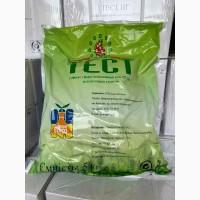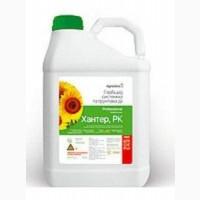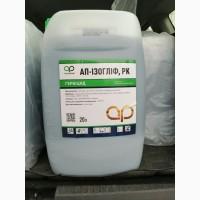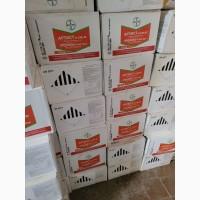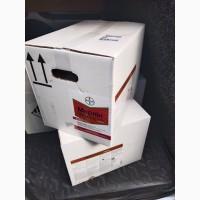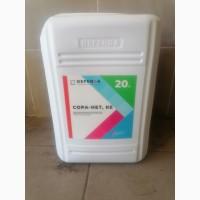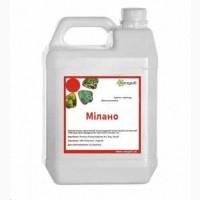/ Fertilizers and plant protection products / Herbicides / Antisapa - highly effective systemic herbicide
Sell / buy
Antisapa - highly effective systemic herbicide, Kyiv region.
Price900|| |135 грн.
Region:all of Ukraine,
Kiev region.
(Vyshhorodok)
Updated:
Antisapa is a highly effective systemic herbicide.
Active substance: Metribuzin 700 g/kg
Chemical group: Triazinones
Preparative form: granules dispersible in water.
WHO classification: III class (moderately toxic)
Maximum number of treatments: 1 time
Packaging: box of 10 kg, the price is indicated for 1 kg.
Advantages of Antisapa herbicide: 160
Високоефективна та довгострокова захисна дія
Wide range of herbicidal action
Destroys growing weeds and their seedlings.
Safe for bees and the environment
Saves time and resources when applying
Compatible with other herbicides on relevant crops.
The herbicide acts both through the leaves and through the soil.
The active substance, penetrating into plants, actively inhibits the growth and division of cells, disrupting their protein and lipid metabolism, which leads to the death of weeds.
The rate of consumption of the working solution: 4-5 liters of water per 1 acre.
Application of Antisapa herbicide
Tomatoes seedlings
Consumption rates: 1 - 1.4 kg/ha
Rate of consumption of working solution: 200-300 l/ha
Harmful object: annual dicots and some monocot weeds
Method, time of processing: spraying the soil before planting seedlings.
Waiting period: -
Tomatoes without seeds
Consumption rates: 0.7 - 1 kg/ha
The rate of consumption of the working solution: 200-300 l/ha
Harmful object: annual dicotyledonous and some monocotyledonous weed species
Method, time of processing: spraying the soil before the emergence of seedlings or in the phase of 2-3 true leaves of the culture.
Waiting period: -
Potato
Spending rates:
0.5 - 1.5 kg/ha - spraying to the seedlings of culture.
0.5 - 0.8 kg/ha - spraying when plants are up to 10 cm tall.
Rate of consumption of working solution: 200-300 l/ha(//tractor-service.com)
Harmful object: annual dicotyledonous and some monocotyledonous weed species
Method, processing time:
spraying to the seedlings of culture
spraying at a plant height of up to 10 cm
Waiting period: -
Soya
Consumption rates: 0.5 - 0.8 kg/ha
Consumption rate of working solution: 200-300 l/ha
Harmful object: annual dicotyledonous and some monocotyledonous weed species
Method, time of processing: spraying the soil to the seedlings of the culture.
Waiting period: -
Alfalfa of the second year
Consumption rates: 0.75 - 1 kg/ha
Rate of consumption of working solution: 200-300 l/ha
Harmful object: annual dicotyledonous and some monocotyledonous weed species
The method and time of cultivation: spraying the soil before the growth of the crop.
Waiting period: -
Time limits for workers to leave treated areas for mechanized work - 3 days, for manual work - 7 days after treatment; seedless tomatoes - does not require/15 days; soy - 3/does not need.
Compatibility of Antisapu herbicide
Compatible with other herbicides on the corresponding crops. Before preparing working mixtures, it is advisable to check the drugs for compatibility (absence of sediment, foam, delamination, beating of lumps, incomplete dissolution of one of the drugs, etc.).
The mechanism of action of Antisapa herbicide
Herbicide Antisapa has a systemic effect.
The herbicide is absorbed both through the leaves and the soil.
The active substance, penetrating into plants, blocks the transport of electrons involved in the process of photosynthesis (photosystem I), which leads to the death of weeds.
The spectrum of action of Antisap herbicide
Cornflower blue, cornflower, quinoa (species), chamomile (species), garden purslane, garden thistle, small-flowered halinsoga, ambrosia, Sophia's curlew, field gorse, medium star,field mustard, лисох , очний колір польовий, грицики звичайна, дурман звичайний, димянка лікарська, пікульник звичайний, кропива (види), льонок звичайний, герань (види), переліска однорічна, вероніка (види), дурнишник (види), фіалка польова.
Features of the use of Antisapa herbicide:
The rate of application of the drug as a soil herbicide depends on the mechanical composition of the soil and the content of humus.
Before spraying, it is necessary to dissolve the calculated amount of the drug in clean water and mix thoroughly.
The working solution should be used on the day of its preparation, because the properties of the drug are lost during long-term storage, which leads to a decrease in the effectiveness of the action against weeds.
Processing should be carried out under favorable weather conditions (absence of gusty wind, air temperature not higher than 25°С), usually in the morning (until 10-11) and evening (18-22) hours.
When using the drug before the appearance of crop seedlings, the presence of soil moisture and the quality of soil preparation are of primary importance for its effectiveness.
In case of insufficient amount of moisture, it is necessary to increase the rate of water consumption, as well as carry out the mandatory laying of the preparation in the soil, with the help of light harrows or other weapons, adjusting the depth to the depth of planting of the cultivated plant.
It is not recommended to use the drug on sandy soils with a very low humus content (less than 1%)
It must be remembered that inter-row cultivation of the soil is not allowed after using the drug.
The next year after using the herbicide, it is not recommended to sow onions and beets in conditions of low humus content (less than 2%).
WARNING! Do not use the drug in greenhouses due to the possibility of phytotoxicity to cultivated plants.
Active substance: Metribuzin 700 g/kg
Chemical group: Triazinones
Preparative form: granules dispersible in water.
WHO classification: III class (moderately toxic)
Maximum number of treatments: 1 time
Packaging: box of 10 kg, the price is indicated for 1 kg.
Advantages of Antisapa herbicide: 160
Високоефективна та довгострокова захисна дія
Wide range of herbicidal action
Destroys growing weeds and their seedlings.
Safe for bees and the environment
Saves time and resources when applying
Compatible with other herbicides on relevant crops.
The herbicide acts both through the leaves and through the soil.
The active substance, penetrating into plants, actively inhibits the growth and division of cells, disrupting their protein and lipid metabolism, which leads to the death of weeds.
The rate of consumption of the working solution: 4-5 liters of water per 1 acre.
Application of Antisapa herbicide
Tomatoes seedlings
Consumption rates: 1 - 1.4 kg/ha
Rate of consumption of working solution: 200-300 l/ha
Harmful object: annual dicots and some monocot weeds
Method, time of processing: spraying the soil before planting seedlings.
Waiting period: -
Tomatoes without seeds
Consumption rates: 0.7 - 1 kg/ha
The rate of consumption of the working solution: 200-300 l/ha
Harmful object: annual dicotyledonous and some monocotyledonous weed species
Method, time of processing: spraying the soil before the emergence of seedlings or in the phase of 2-3 true leaves of the culture.
Waiting period: -
Potato
Spending rates:
0.5 - 1.5 kg/ha - spraying to the seedlings of culture.
0.5 - 0.8 kg/ha - spraying when plants are up to 10 cm tall.
Rate of consumption of working solution: 200-300 l/ha(//tractor-service.com)
Harmful object: annual dicotyledonous and some monocotyledonous weed species
Method, processing time:
spraying to the seedlings of culture
spraying at a plant height of up to 10 cm
Waiting period: -
Soya
Consumption rates: 0.5 - 0.8 kg/ha
Consumption rate of working solution: 200-300 l/ha
Harmful object: annual dicotyledonous and some monocotyledonous weed species
Method, time of processing: spraying the soil to the seedlings of the culture.
Waiting period: -
Alfalfa of the second year
Consumption rates: 0.75 - 1 kg/ha
Rate of consumption of working solution: 200-300 l/ha
Harmful object: annual dicotyledonous and some monocotyledonous weed species
The method and time of cultivation: spraying the soil before the growth of the crop.
Waiting period: -
Time limits for workers to leave treated areas for mechanized work - 3 days, for manual work - 7 days after treatment; seedless tomatoes - does not require/15 days; soy - 3/does not need.
Compatibility of Antisapu herbicide
Compatible with other herbicides on the corresponding crops. Before preparing working mixtures, it is advisable to check the drugs for compatibility (absence of sediment, foam, delamination, beating of lumps, incomplete dissolution of one of the drugs, etc.).
The mechanism of action of Antisapa herbicide
Herbicide Antisapa has a systemic effect.
The herbicide is absorbed both through the leaves and the soil.
The active substance, penetrating into plants, blocks the transport of electrons involved in the process of photosynthesis (photosystem I), which leads to the death of weeds.
The spectrum of action of Antisap herbicide
Cornflower blue, cornflower, quinoa (species), chamomile (species), garden purslane, garden thistle, small-flowered halinsoga, ambrosia, Sophia's curlew, field gorse, medium star,field mustard, лисох , очний колір польовий, грицики звичайна, дурман звичайний, димянка лікарська, пікульник звичайний, кропива (види), льонок звичайний, герань (види), переліска однорічна, вероніка (види), дурнишник (види), фіалка польова.
Features of the use of Antisapa herbicide:
The rate of application of the drug as a soil herbicide depends on the mechanical composition of the soil and the content of humus.
Before spraying, it is necessary to dissolve the calculated amount of the drug in clean water and mix thoroughly.
The working solution should be used on the day of its preparation, because the properties of the drug are lost during long-term storage, which leads to a decrease in the effectiveness of the action against weeds.
Processing should be carried out under favorable weather conditions (absence of gusty wind, air temperature not higher than 25°С), usually in the morning (until 10-11) and evening (18-22) hours.
When using the drug before the appearance of crop seedlings, the presence of soil moisture and the quality of soil preparation are of primary importance for its effectiveness.
In case of insufficient amount of moisture, it is necessary to increase the rate of water consumption, as well as carry out the mandatory laying of the preparation in the soil, with the help of light harrows or other weapons, adjusting the depth to the depth of planting of the cultivated plant.
It is not recommended to use the drug on sandy soils with a very low humus content (less than 1%)
It must be remembered that inter-row cultivation of the soil is not allowed after using the drug.
The next year after using the herbicide, it is not recommended to sow onions and beets in conditions of low humus content (less than 2%).
WARNING! Do not use the drug in greenhouses due to the possibility of phytotoxicity to cultivated plants.
|
Store, contacts | |
Yuriy/ отзывы, инфо. / activity evaluation | |
|
Phone:
+38 (xxxxxx
show
| |
All user ads ~1000 | |
Ad ID: #1318430
(added by a registered user, registration date: 10-08 -2016)
Added / Updated: 09-10-2024 08:53 (relevant, until: 09-10-2025)
Permanent ad address:
Showed / watched for today: ?, total: ?
Similar ads
Among them are many interesting...
